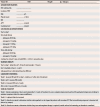Treatment of deep vein thrombosis: what factors determine appropriate treatment?
- PMID: 15751565
- PMCID: PMC1472974
Treatment of deep vein thrombosis: what factors determine appropriate treatment?
Abstract
Objective: To identify patients with deep vein thrombosis (DVT) for whom in-hospital treatment should be considered.
Quality of evidence: The literature was searched for studies on outpatient treatment of DVT. Seventeen studies were assessed: seven were randomized controlled trials (level I evidence), and 10 were non-randomized trials (level II evidence).
Main message: Four criteria can be used to identify patients with DVT for whom outpatient treatment might not be appropriate: presence of massive DVT, presence of symptomatic pulmonary embolism, high risk of bleeding with anticoagulant therapy, and presence of comorbid conditions or other factors that warrant in-hospital care.
Conclusion: Four criteria can be used to identify patients with DVT for whom in-hospital treatment should be considered.
OBJECTIF: Identifier les cas de thrombose veineuse profonde (TVP) pour lesquels un traitement à l’hôpital devrait être envisagé.
QUALITÉ DES PREUVES: On a fouillé la littérature à la recherche d’études sur le traitement extra-hospitalier de la TVP. Dix-sept études ont été évaluées, dont 7 essais randomisés (preuves de niveau I) et 10 essais non randomisés (preuves de niveau II).
PRINCIPAL MESSAGE: On peut déterminer les cas de TVP pour lesquels un traitement extra-hospitalier risque d’être inapproprié en utilisant quatre critères : la présence d’une TVP massive, une embolie pulmonaire symptomatique, un haut risque d’hémorragie en cas de traitement anticoagulant et la présence d’un état de comorbidité ou d’autres facteurs requérant des soins hospitaliers.
CONCLUSION: Quatre critères peuvent être utilisés pour déterminer les cas de TVP pour lesquels un traitement à l’hôpital devrait être envisagé.
Figures
Comment in
-
Nontreatment of deep vein thrombosis.Can Fam Physician. 2005 May;51(5):654; author reply 654-5. Can Fam Physician. 2005. PMID: 15934264 Free PMC article. No abstract available.
Similar articles
-
Eligibility for home treatment of deep vein thrombosis: a prospective study in 202 consecutive patients.J Vasc Surg. 2001 Dec;34(6):1065-70. doi: 10.1067/mva.2001.118821. J Vasc Surg. 2001. PMID: 11743562
-
Incidence, risk factors, and treatment patterns for deep venous thrombosis in hospitalized children: an increasing population at risk.J Vasc Surg. 2008 Apr;47(4):837-43. doi: 10.1016/j.jvs.2007.11.054. Epub 2008 Mar 4. J Vasc Surg. 2008. PMID: 18295440
-
Inconsistencies in the planning of the duration of anticoagulation among outpatients with acute deep-vein thrombosis. Results from the OTIS-DVT Registry.Thromb Haemost. 2011 Feb;105(2):239-44. doi: 10.1160/TH10-08-0506. Epub 2010 Sep 30. Thromb Haemost. 2011. PMID: 20886197
-
What is the optimal duration of treatment for DVT? An update on evidence-based medicine of treatment for DVT.Semin Vasc Surg. 2010 Sep;23(3):182-91. doi: 10.1053/j.semvascsurg.2010.05.006. Semin Vasc Surg. 2010. PMID: 20826296 Review.
-
Treatment of deep vein thrombosis.Semin Vasc Med. 2001;1(1):43-54. doi: 10.1055/s-2001-14669. Semin Vasc Med. 2001. PMID: 15199513 Review.
Cited by
-
Direct-Acting Oral Anticoagulants: Practical Considerations for Emergency Medicine Physicians.Emerg Med Int. 2016;2016:1781684. doi: 10.1155/2016/1781684. Epub 2016 May 16. Emerg Med Int. 2016. PMID: 27293895 Free PMC article. Review.
-
Management of venous thromboembolism: an update.Thromb J. 2016 Oct 4;14(Suppl 1):23. doi: 10.1186/s12959-016-0107-z. eCollection 2016. Thromb J. 2016. PMID: 27766049 Free PMC article. Review.
-
Ambulation after deep vein thrombosis: a systematic review.Physiother Can. 2009 Summer;61(3):133-40. doi: 10.3138/physio.61.3.133. Epub 2009 Jul 16. Physiother Can. 2009. PMID: 20514175 Free PMC article.
-
American Society of Hematology 2020 guidelines for management of venous thromboembolism: treatment of deep vein thrombosis and pulmonary embolism.Blood Adv. 2020 Oct 13;4(19):4693-4738. doi: 10.1182/bloodadvances.2020001830. Blood Adv. 2020. PMID: 33007077 Free PMC article.
-
Recurrent deep vein thrombosis following brown recluse spider bite complicated by medication noncompliance and residual scar tissue: A rare case report.Clin Case Rep. 2023 Apr 25;11(4):e7263. doi: 10.1002/ccr3.7263. eCollection 2023 Apr. Clin Case Rep. 2023. PMID: 37113635 Free PMC article.
References
-
- Tsai AW, Cushman M, Rosamund WD, Heckbert SR, Polak JF, Folsom AR. Cardiovascular risk factors and venous thromboembolism incidence: the longitudinal investigation of thromboembolism etiology. Arch Intern Med. 2002;162(10):1182–1189. - PubMed
-
- Hanson PO, Welin L, Tibblin G, Eriksson H. Deep vein thrombosis and pulmonary embolism in the general population. “The Study of Men Born in 1913.”. Arch Intern Med. 1997;157(15):1665–1670. - PubMed
-
- Hyers TM, Agnelli G, Hull RD, Morris TA, Samama M, Tapson V, et al. Antithrombotic therapy for venous thromboembolic disease. Chest. 2001;119(Suppl 1):176–193. - PubMed
-
- Dolovich LR, Ginsberg JS, Douketis JD, Holbrook AM, Cheah G. A meta-analysis comparing low-molecular-weight heparins with unfractionated heparin in the treatment of venous thromboembolism: examining some unanswered questions regarding location of treatment, product type, and dosing frequency. Arch Intern Med. 2000;160(2):181–188. - PubMed
-
- Hirsh J, Warkentin TE, Shaughnessy SG, Anand SS, Halperin JL, Raschke R, et al. Heparin and low-molecular-weight heparin: mechanism of action, pharmacokinetics, dosing, monitoring, efficacy, and safety. Chest. 2001;119(Suppl 1):64–94. - PubMed
Publication types
MeSH terms
Substances
LinkOut - more resources
Full Text Sources
Medical
Research Materials

